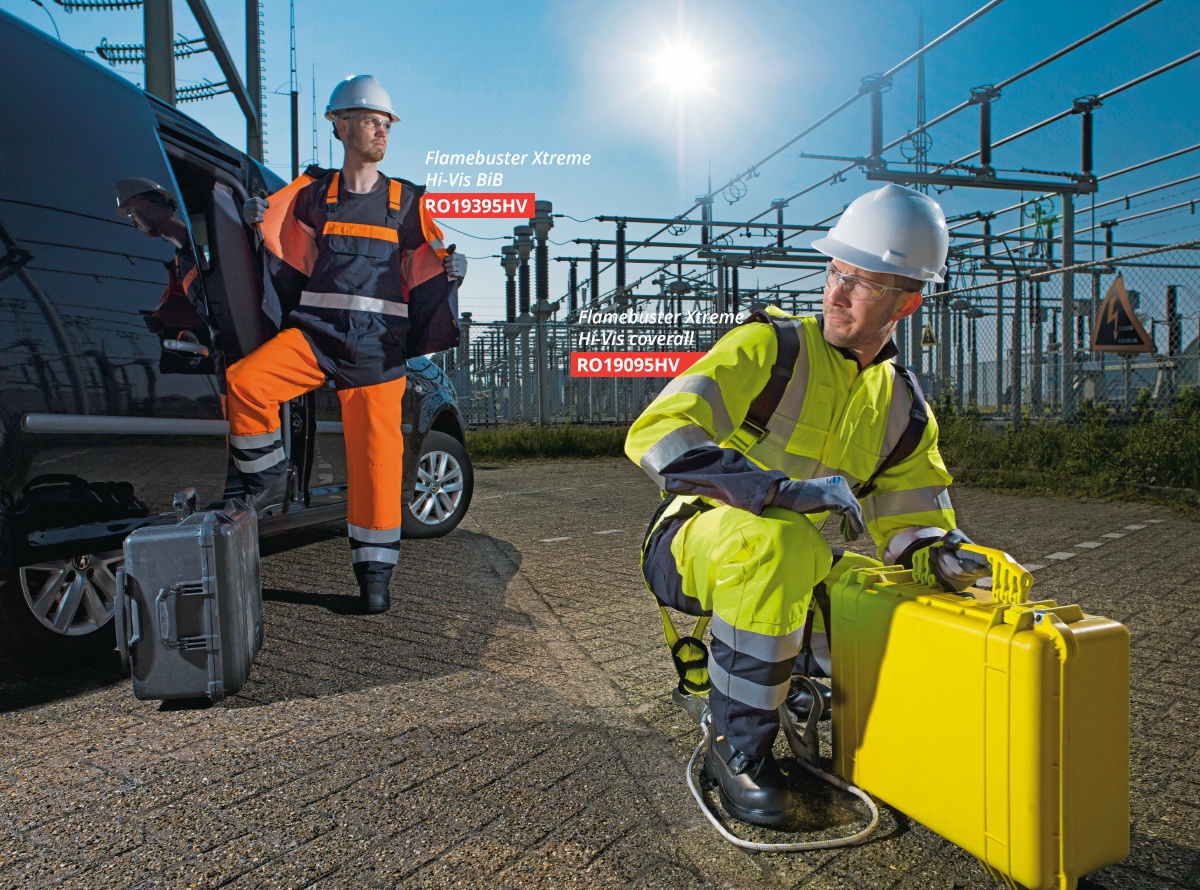How to choose the correct fabric
What to pick and where to start?
Choosing the correct garment must always begin with prior knowledge of the performance and the capabilities of the fabric. The production process and timeline is secondary.
Too often, the end-user specifies a fabric of their own choice and one that must meet a certain number of EN norms. For ROOTS this is often insufficient.
We ask the customer at all times where and how the FR clothing is to be used, about their laundry provider and what expectations they may have from a garment. It is often the case that ROOTS, after weighing up all the factors, will recommend a different fabric choice to what the end-user originally specified.
Determining the right fabric choice is very difficult, partly because a balance must be made between personal safety, comfort, laundry conditions and the nature and location of a working environment. Listening is one of our strengths and for that reason, we do not automatically follow the fabric choice of the customer - as experts, we make our own judgements!
The first question that must be answered; Does the customer require an inherent flame retardant fabric or a treated fabric.
Why would someone choose inherent flame retardant fabrics?
Almost always, people will indicate that this choice will be made due to the safety of the wearer, meaning a belief that inherently flame retardant (IFR) garments are the safest products on offer as they are also the most expensive... On the reverse side, people have the wrong impression of treated fabrics and think that FR treatments can be easily washed out of treated garments.
There is indeed an important point to consider, especially if a customer has limited or no control over their laundry processes.
Example: Offshore Platform Laundering
Contractors working on an offshore platform have their FR garments laundered by a contract catering company who are under constant time constraints to launder garments within a set time period leading to the use of wrong washing / drying temperatures and inappropriate detergents. the result is excessive shrinkage, broken zippers, non-reflective tape, colour fading and the potential loss of flame retardancy.
If you control the laundry process and educate the caterer and platform owners, then treated fabrics more often than not can be an excellent choice of fire protection. This is something we at ROOTS talk about time and time again - backed up with results.
One common misconception is that people think that properties of an inherently flame retardant fabric offer more protection - but this is not true and is a proven fact through independent manikin testing.

It should be noted however that treated fabrics are more often heavier fabrics per cm2 than most inherently flame retardant fabrics.
There is indeed much to support the use of inherently flame retardant fabrics.
- Inherent fabrics can make lightweight garments - a must for hot climates.
- Inherent fabrics are a must if home (or non-controlled) washing is taking place.
- Inherent fabrics offer very good arc flash properties.
- Inherent fabrics can be solution-dyed.
But why are sales numbers still relatively low compared to treated fabrics?
- Value for Money is often not achieved ith inherent flame retardant fabrics. For example, the presence of retro-reflective bands has a lifespan of 50 washes max - a poor return of investment.
- An industrial laundry process is often so aggressive that the fabric might survive but the stitching and accessories may not.
- Expensive! Inherent aramid fabrics such as Nomex, Kermel and Protex last longer but still can suffer from points 1 and 2.
Fabric choices for hot climates
When people work in hot conditions such as in the Middle East, for example, the customer will always opt for a lightweight fabric. It is obvious to do this to avoid body stress and/or dehydration.
Treated fabrics have limitations compared to inherent fabrics. For treated fabrics, 250 grams is actually the minimum weight in terms of offering the wearer acceptable protection - remember, the lighter the fabric, the less FR protection is provided. Also, the tensile strength and tear resistance are very difficult to achieve under the EN requirements for treated fabrics. Having said that, ROOTS hopes to be able to bring to market a 205g treated cotton which will tick all of the boxes which could sit nicely alongside our 170g Flamebuster Extreme inherent garment.
The following 6 images are manikin test results which give a burn injury prediction in the case of a flash fire of 4 seconds. All tested coveralls are washed and dried for 50 cycles according to the garment care instructions prior to testing.
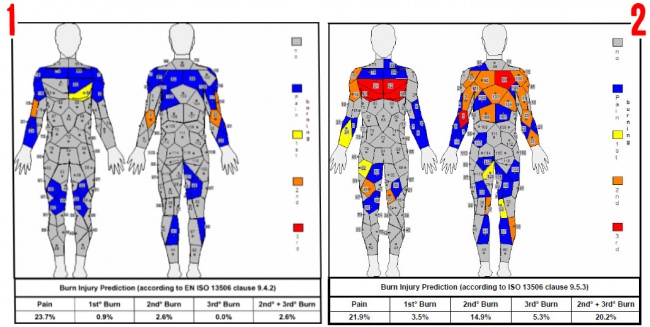
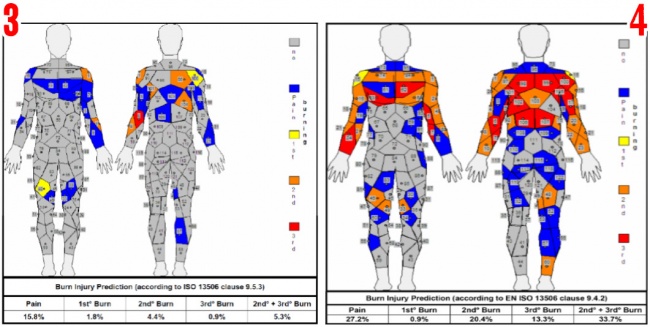
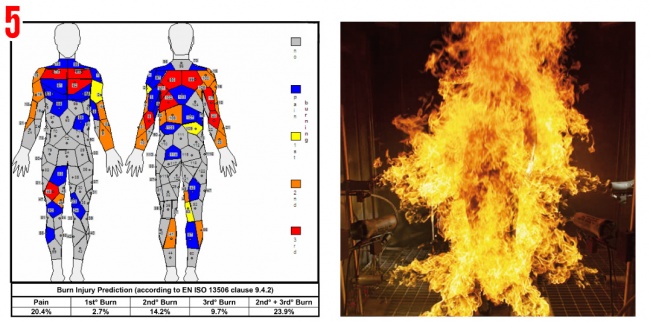
Test results, all of these tests were done after 50 washing cycles.
- Flamebuster 350 gram 2nd° + 3rd° Burn = 2,6%
- Flamebuster 250 gram 2nd° + 3rd° Burn = 20,2%
- 80% cotton / 20% polyester 320 gram 2nd° + 3rd° Burn = 5,3%
- Westex 65% cotton / 35% polyester 320 gram 2nd° + 3rd° Burn = 33,7%
- Kermel Alpha 230 2nd° + 3rd° Burn = 23,9%
What conclusions can be drawn from the above test results?
- Not all treated fabrics perform the same. Compare the outcome of the Flamebuster 350 with the 65% cotton / 35% polyester fabric.
- Even between two 65% cotton / 35% polyester fabrics, there is a big difference in performance.
- Light fabrics (250 grams and less) give relatively larger burn areas.
- The rule that inherent fabrics offer much more protection is false
- There are definitely 'dangerous' fabrics on the market today
- There are exceptional fabrics on the market because ROOTS need not be ashamed of the results of Flamebuster 350 (2.6% Burn, only second degree) and 250 (20,2% of which only 5.3% in third-degree). No similar fabric(s) of the competition offers the same level of protection.
The following pro's and con's table show the main difference between the two types of fabrics.
The top table shows treated fabrics whilst the lower table shows inherently flame retardant fabrics.
| Pro's for ROOTS treated fabrics maintained correctly. |
Con's treated fabric |
| Relatively fewer burns and less substantial burns, if maintained properly. | Fire retardant properties are not permanent. |
| Suitable for general safety, but also for welding, grinding and burning. | Relatively heavy compared to inherent fabrics. |
| More comfort than most inherent flame retardant fabrics. | More shrinkage if miss-laundered. |
| Best value for money in flame retardant protection. | Lifespan purely depends on correct maintenance i.e. following the information label instructions. |
| Pro's inherent flame retardant fabrics. | Con's inherent flame retardant fabrics. |
| Flame retardant properties are permanent and cannot be washed out. | Relatively high burn rate (partly due to lower fabric weight). |
| Ideal for general safety. | Not suitable for welding, grinding and burning |
| Lightweight when compared to treated fabrics | The lack of natural fibres such as cotton makes it less comfortable in terms of sweating. |
| Excellent value for money if garments can be laundered over 150 cycles. | In many cases poor value for money due to poor maintenance conditions. |
If the customer stipulates an inherent flame retardant fabric a discussion needs to take place about these fibres as each one has their individuals performance(s).
There are a few inherent flame retardant fabrics on the market today;
- Nomex from DuPont. A good fibre and fabric. Almost always full aramids are used meaning it is rare for mixing with other flame retardant fabrics. Nomex is almost always 'piece-dyed' supplied. This means that the fabric is dyed after the weaving.
- Kermel is a fibre similar to Nomex. Whilst DuPont is the market leader in the USA, UK, Benelux and Germany, it is Kermel who is the leader in the more southern European countries such as France, Spain and Italy. Kermel is 'solution dyed' meaning that the fibre itself is coloured. This is also possible for Nomex, but DuPont increases the price substantially for this option.
- Conex is a manufacturer but is virtually non-existent in Europe.
- Protex is very important. Protex (Japan) is the basis for many fabrics under various brands on the market such as Tecasafe. Unlike Kermel and Nomex, Protex fibres are significantly weaker. A 100% Protex fabric does not exist. Protex is inherently flame retardant but should always be mixed for example with Kermel but the most common blending is with cotton (like Tecasafe). The yarns are intimately mixed and are referred to as 'inherent'. Protex is relatively easy to copy and this results in many Protex copies on the market that are not actually Protex.
- Chinese Aramids are becoming increasingly important as the Chinese can produce some brilliant aramid fibres/fabrics. Modacrylic fabrics, for example, are on the rise in the European market and our very own developed Flamebuster Xtreme has witnessed a real spike in demand since its launch back in 2011.
It is clear from the above that even with the inherent fabrics, making the right fabric choice is not so simple.
It is important to note that inherent flame retardant fabrics are not so suitable for welding and/or grinding activities. The man-made fibres associated with IFR fabrics do not allow the sparks and spatter to bounce from the face of the fabric such as moleskin treated 100% cotton for example.
If the choice is a treated fabric which fabric do we recommend and why?
There are four rules of thumb to remember when picking the correct fabric:
- Laundries are not fond of flame retardant clothing because in many cases they are a disruption to their normal day to day conventional washing processes, which are fully furnished on cotton/polyester (65/35)
First of all, they wash the garments wrong (too hot) and then 8 out of 10 laundries use a tunnel drying process - this is where things really go wrong! The tunnels are heated up to approximately 130-160°C which is about 100°C more than indicated in our washing instructions. Secondly, the biggest problem is the time the clothing is placed in the tunnel that they normally base on a cotton/polyester (65/35) fabric because, as mentioned previously, this is essentially the blend of the majority of garments going through a laundry process. A cotton/polyester (65/35) garment is dry after a normal tunnel drying process. However, a 100% cotton garment is still damp. The simple reason for this is that polyester dries very quickly, whereas cotton needs more time to dry. The laundry, in this case, sends the garments through the tunnel again for further drying. Herein lies the error because during that second tunnel drying process the moisture is quickly gone from the 100% cotton fabric and excessive shrinkage occurs. It is a myth as to how cotton shrinks more than cotton/polyester (65/35). However, if the washing instructions are followed accordingly, there will never be any issues whatsoever. - The more polyester a fabric contains, the higher the burn injury will be in case of a flash fire (see manikin test results)
- Large amounts of polyester can only be made flame retardant through Proban. Proban encapsulates the fibre, while Pyrovatex binds into the fire. It is not possible to go further than 20% polyester when treating with Pyrovatex. The problem with Proban is the large amount of Formaldehyde content. It may work well in practice, but may not be permitted under various laws in various countries. to ROOTS, Proban is controversy to the mission statement in which health and safety of the wearer are the true basis for our actions.
- Polyester for welding is less safe but it is practically useful. During welding or grinding the garment is subjected to sparks or molten metal resulting in black spots where the fabric is carbonised. Nothing wrong here, but during a washing process, where a lot of mechanical action takes place, the black spot areas break open. The problem with cotton is that the hole will continue to widen due to fraying. But the more polyester the less the fabric will fray.
See below pictures, from left to right: Flamebuster 350 100% cotton | ROOTS CR8020 80% cotton / 20% polyester | Tecafort 65% cotton / 35 % polyester.
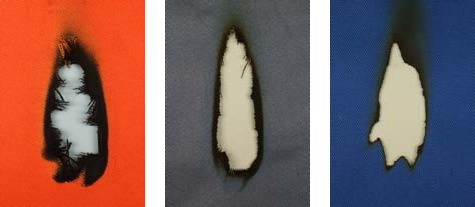
There is indeed an excellent alternative to the 65% cotton / 35% polyester fabric within the ROOTS collection.
